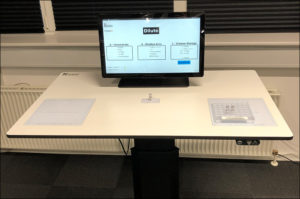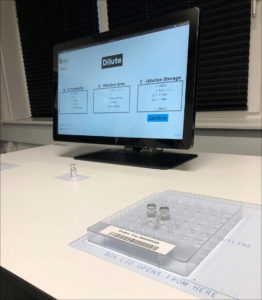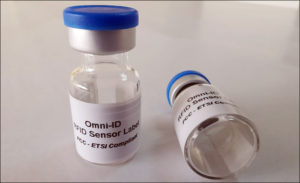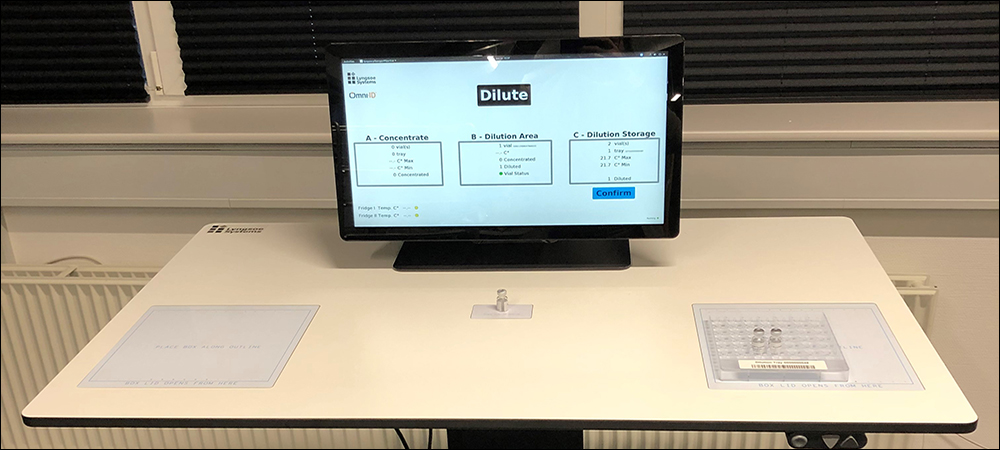Lyngsoe Systems has developed a solution to track every COVID-19 vaccine vial from receipt at a clinic to a patient’s arm, using UHF RFID sensor-based tags to detect the temperature and liquid level of each vial being stored and then used to administer vaccines to patients. Additionally, Bluetooth Low Energy (BLE) enables the real-time management of temperatures within a clinic’s coolers and freezers. The solution is intended to automate data collection regarding the administration of vaccines, as well as to help users confirm the temperature of a given vaccine, along with its authenticity and expiration date, and whether it has been properly diluted prior to being administered to a patient.
Customers that will deploy the technology are typically governments and vaccine manufacturers, according to Lyngsoe. The firm developed the solution based on its existing cold supply chain tracking technology, which is used by the fresh food industry. The vaccine-management system it designed includes RFID sensor labels developed and manufactured by Omni-ID, with built-in temperature- and liquid-sensing functionality, using chips and sensing capabilities from Axzon (formerly RFMicron). These sensor-based passive UHF RFID inlays are integrated into a drug company’s printed vaccine labels.

Lyngsoe’s Healthcare Mate workstation comes with its own RFID reader and antenna arrays, while handheld RFID readers can be used to interrogate tags at smaller clinics where the vaccines are stored and injected into patients’ arms. Data is captured and managed via Lyngsoe’s software on an edge server or in the cloud. Finally, Lyngsoe provides BLE beacons that can be installed in coolers and freezers. The beacons transmit real-time data to a BLE gateway in the workstation, which forwards that data to the server.
“We believe this is something which has not been seen before,” says Keld Ole Nielsen Refers, Lyngsoe’s director of business development. “We are proud of what is a fairly low-cost solution,” he adds, which is intended to ensure not only that vaccines are properly handled and delivered to patients, but also that data about each injection can be stored in a central database. “We now have the capacity to manufacture [tags and reader stations] in large numbers.”

Keld Ole Nielsen Refers
Governments and healthcare providers are tasked this year with an unprecedented challenge: inoculating billions of people with vaccines being manufactured by multiple companies—and each product has its own storage requirements, including temperature levels and expiration dates. Clinicians must administer the vaccines as efficiently as possible, while managing multiple potential challenges, including counterfeit products, expired vaccines or temperature excursions from the acceptable range. Additionally, mistakes can be made during the diluting process. For example, eight German home-care workers were recently injected with five times the intended dose of vaccine because the product had not been diluted with water.
Lyngsoe’s solution is designed to address the issues of tracking and ensuring the safety of vaccines as they are administered, says Christian Meinhardt, the firm’s sales director for retail and logistics, by alerting clinicians if an expiration date is approaching or has passed, as well as when temperature thresholds have been exceeded or other mistakes are being made. Lyngsoe worked with Omni-ID and Axzon to develop the specialized inlay that enables the tracking of each vaccine and all sensor-based conditions.
The inlay is equipped with a perma-locked vaccine vendor identifier, with a unique serial number encoded on it. It enables users to create a perma-locked digital signature so the inlay data can be captured, updated and locked in the software. That information includes temperature requirements and expiration dates. A manufacturer’s label with the built-in inlay is then applied to each vial containing concentrated vaccines. Once tags are applied to vaccines and commissioned into the software, the vaccines are shipped in boxes within temperature-controlled environments.
 Clinics participating in the system will need to have acquired either the Lyngsoe Healthmate workstation reader or a handheld reader from Lyngsoe (manufactured by a variety of vendors), or both. As the boxes are received, they can be placed on the workstation desktop, where the built-in RFID reader will capture tag IDs and update the software to indicate the vials have been received. Temperature data is also captured, and the software will confirm that the products have remained within the appropriate temperature perimeters. Personnel place the vaccines in coolers or freezers until they are used.
Clinics participating in the system will need to have acquired either the Lyngsoe Healthmate workstation reader or a handheld reader from Lyngsoe (manufactured by a variety of vendors), or both. As the boxes are received, they can be placed on the workstation desktop, where the built-in RFID reader will capture tag IDs and update the software to indicate the vials have been received. Temperature data is also captured, and the software will confirm that the products have remained within the appropriate temperature perimeters. Personnel place the vaccines in coolers or freezers until they are used.
The software manages “first in, first out” (FIFO) data to ensure that vaccines closest to their expiration dates are used first. As the vaccines are prepared for injection into a patient’s arms, they are removed from cold storage and placed on the workstation. The station has three antenna arrays dedicated to different tasks; the antennas were designed by Lyngsoe’s engineers in Canada and Denmark. The box of vaccines can be placed on the left-hand side of the station, where it will be read by an array of UHF reader antennas at short-range. The reader captures each tag ID, and the software (hosted on an edge device built into the workstation) confirms temperature levels and expiration dates. That data is also forwarded to central server-based software.
As each vaccine vial is used, it is removed from the box and placed on a bullseye at the center of the station. Another reader antenna then captures the individual tag ID, as well as the temperature and liquid levels. Each vial is only partially filled with medication, and clinicians must add water to dilute it before administering it to a patient. As they do so, the tag senses changes in temperature and liquid volume, and it forwards that update to the software via the bullseye antenna.

Christian Meinhardt
The workstation touchscreen then displays a green light to confirm that the vaccine is ready. The vial is next moved to the third antenna array, located on the right-hand side of the station. For each patient (a vial can usually accommodate five), the clinician selects a prompt indicting that the first patient has received a dose, then the second, and so on. The system continues to read data about the temperature and the amount of fluid in the vial.
If, at any time throughout the process, vaccine vials or diluted vaccines are approaching the predefined expiration thresholds, based on the amount of that has time passed or the temperature, an alarm is displayed at the station. The software then forwards an alert to healthcare personnel, either via SMS text message or e-mail. “If a threshold is crossed,” Meinhardt says, “individual vials can be quarantined and blocked in the system.” Nielsen Refers adds, “Since you have very tight boundaries for each vaccine, you have to know ‘Exactly how much time do I have for each individual vaccine?,’ ‘When was it diluted?’ and ‘How much time do I have left to use it after it is diluted?'”
Once a vial is fully administered, the software updates its status as empty, after which the reader disables the tag ID so the vial can never be reused, and users are instructed to discard it. All blocked vials and discarded vaccines are registered in the software, allowing authorized parties to obtain the real-time status of any completed transactions, as well as view any quarantined vaccines. This information is automatically stored and can be retrieved on a regional or national level.
The tags are capable of both long- and short-range reads. Bulk-quantity reads with a handheld or station reader can capture all tags within a box at distances of up to 1.5 meters (4.9 feet). Therefore, an individual with a handheld reader can move through a storage area to capture all tag reads within a short amount of time, in order to obtain an update regarding vaccine inventory levels. Lyngsoe has been working on the solution since it and its partners decided to develop a system to support global vaccination logistics and processes. The company now has the capacity to manufacture inlays and read stations in large numbers.

In the long term, the company reports, the technology could continue to serve the pharmaceutical industry after the pandemic has passed. For instance, Nielsen Refers says, the tags could be used for a variety of vaccines and other drugs that must be administered in high volumes. “We feel that combining the ability to read the label with temperature plus fluid level is groundbreaking,” Meinhardt states. In most cases, he adds, the tags are capable of measuring temperatures within 0.5 degrees, and they can operate at temperatures as low as -80 degrees Celsius (-112 degrees Fahrenheit).
Handheld readers can be used as an alternative to the workstation for smaller clinics, the company notes, or in conjunction with workstations at some larger sites. A handheld can be carried around a warehouse or through coolers to capture inventory reads, as well as to interrogate each vial as it moves through receiving and administration processes, using an application that forwards data to the server.
The technology is expected not only to help move vaccines through administration safely at specific temperatures, Meinhardt says, but also to aid those who might be using products provided by multiple vendors. “Temperature boundaries are different depending on the vaccine,” he explains. “They have to be diluted within a narrow threshold of time when removed from the cooler.”
Clinics will need to be able to document each vaccination and create a digital trail in order to prove they followed the proper procedures. The technology could be built into a transportation system, Nielsen Refers says, to track data regarding the vaccines, along with temperature levels and other conditions as they are transported to customer clinics. The company says the price for the RFID-enabled label, and for all other components of the solution, would typically amount to 0.5 to 1 percent of the total vaccine’s cost.


